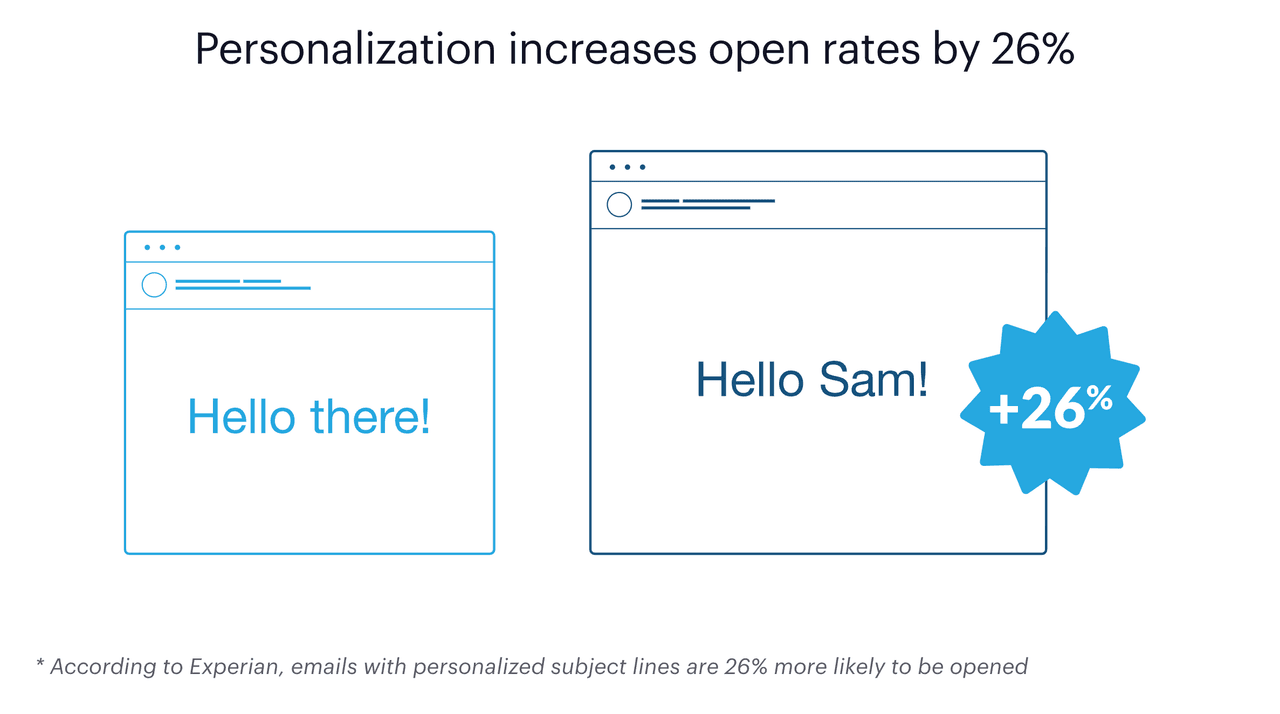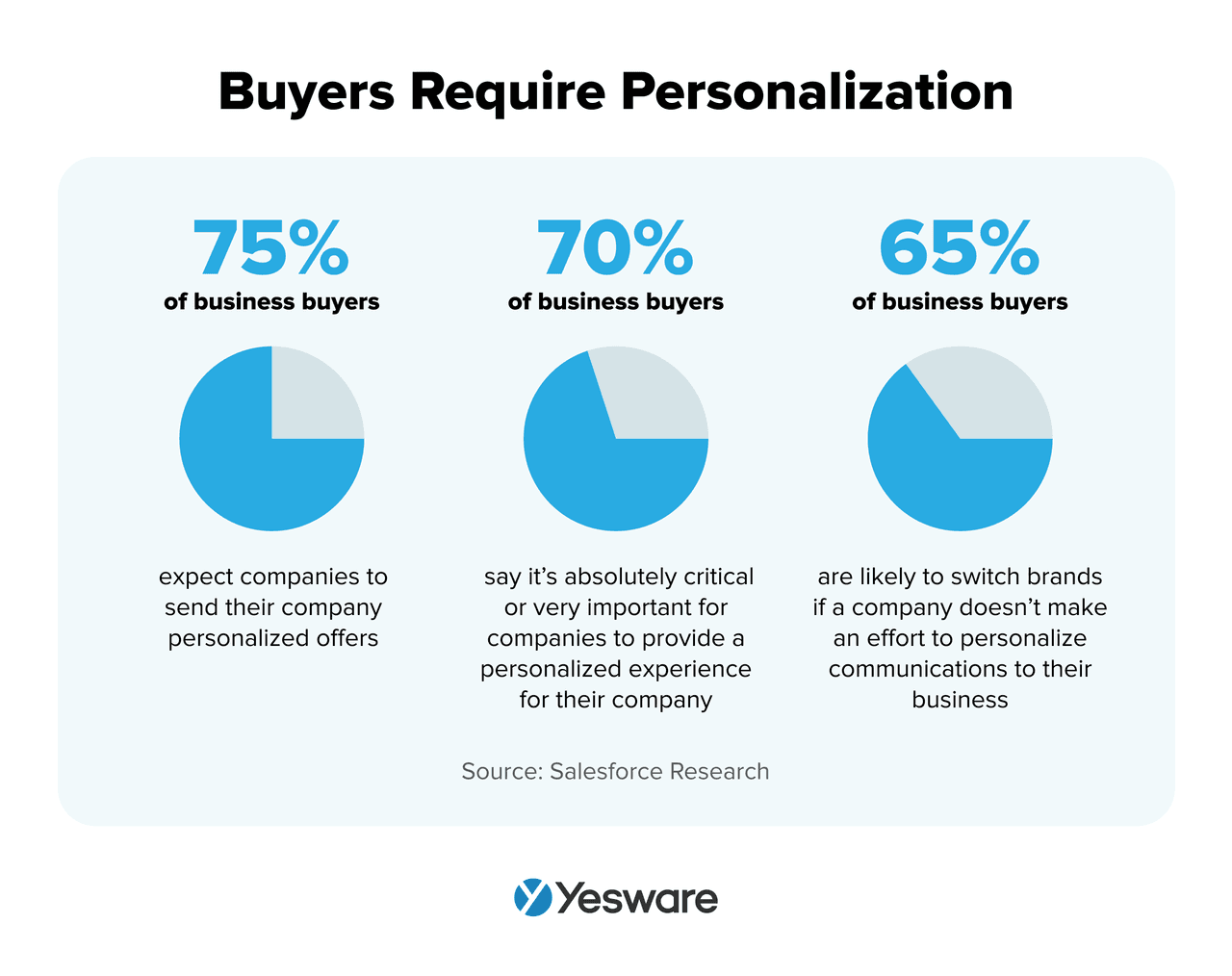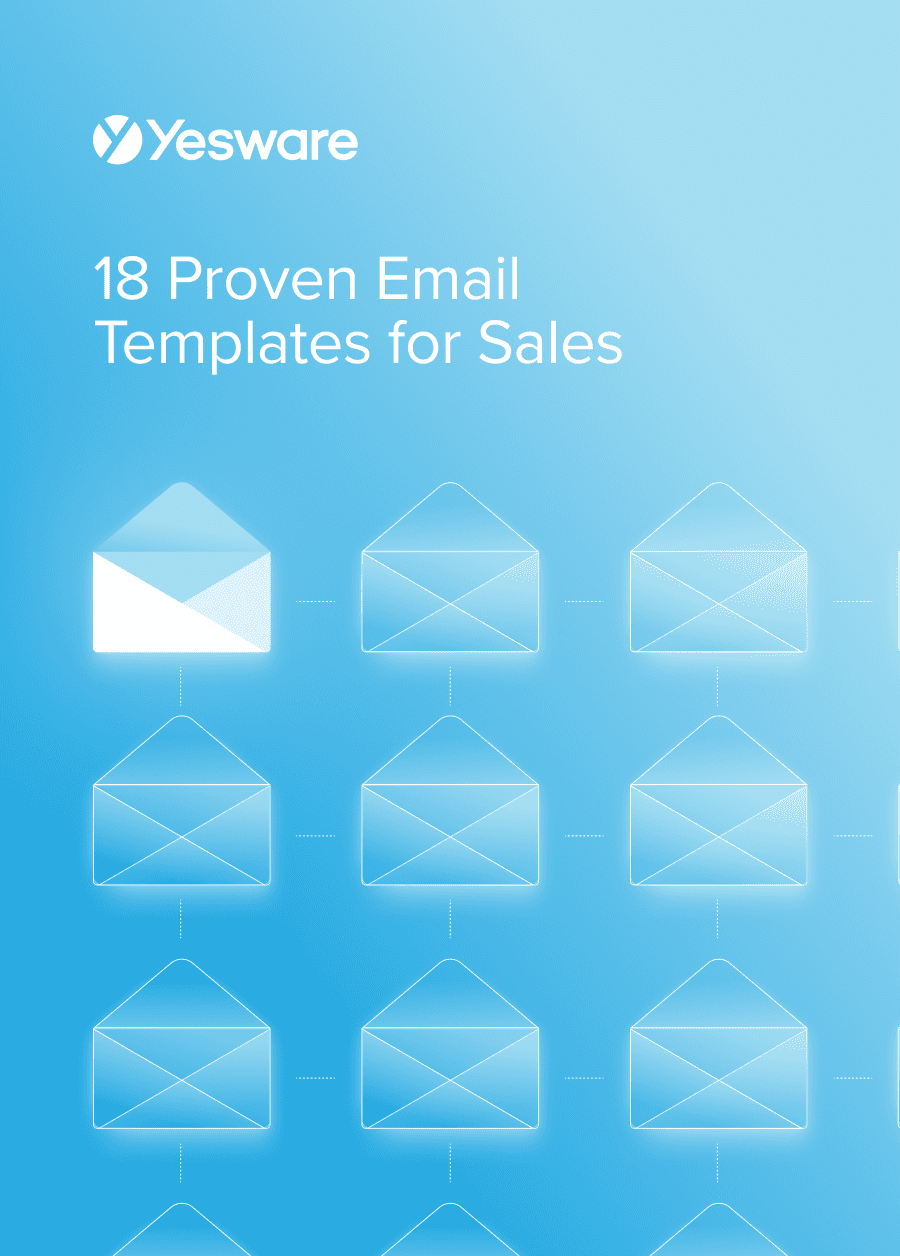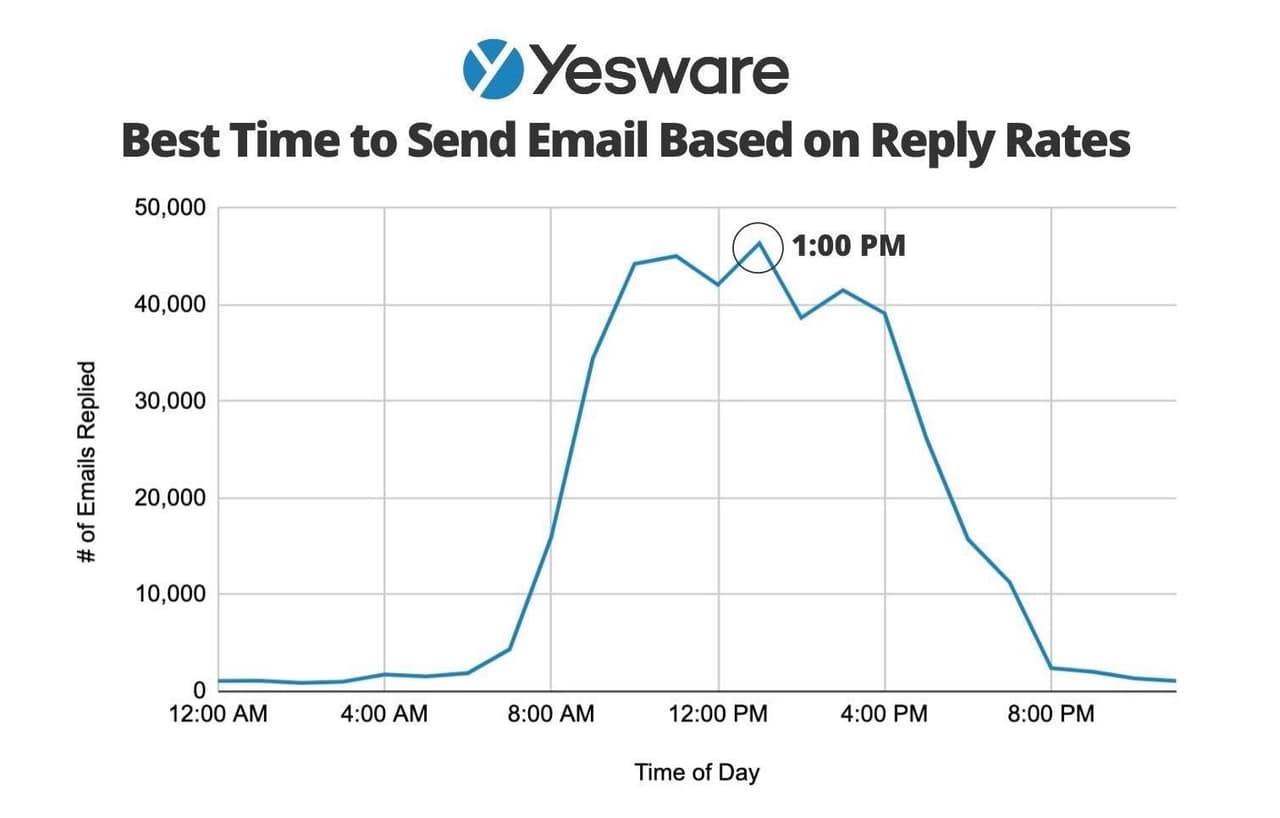Breaking Up is Hard: Tips for Sales Breakup Emails
Casey O'Connor
Contents
A sales breakup email is somewhat misleading for the type of outreach it covers because the intention of these messages isn’t necessarily to part ways with the recipient — at least, not in every instance.
While pausing or ending a sales relationship is sometimes the outcome of a sales breakup email, the reality is that sales reps actually send these types of messages as an urgency-fueled way to provoke a response from a recipient that hasn’t interacted with them or their brand in a while.
Some prospects who receive sales breakup emails reply and re-engage, some hit pause for internal considerations, and still, others opt-out for good—but in all cases, the sales breakup email has done its job if the communication loop is successfully closed. That deal can now either continue to progress through the sales funnel or exit the pipeline so that sales reps stop allocating them resources.
In this article, we’ll go over everything you need to know about sales breakup emails, including the reasons you might send one, how (and, most importantly, when) to send a successful one, and some examples to help get you started.
Here’s what we’ll cover:
- What Is a Sales Breakup Email?
- Reasons for Breaking Up in Sales
- Key Components of an Effective Sales Breakup Email
- How to Structure Your Sales Breakup Email
- When to Send a Sales Breakup Email
- Common Mistakes to Avoid
- Effective Sale Breakup Email Examples & Template
- FAQs
What Is a Sales Breakup Email?
 A sales breakup email is a sales rep’s final attempt to contact a prospect with whom they have not interacted for a prolonged period of time.
A sales breakup email is a sales rep’s final attempt to contact a prospect with whom they have not interacted for a prolonged period of time.
This type of email is sent after all other follow-up strategies have been exhausted, the prospect continues to be unresponsive, and the sales rep needs to decide how to continue to allocate their sales resources.
Usually, their goal is to gracefully end the sales conversation (at least for the time being) while maintaining professionalism.
But sales break up emails are used for a lot more than just “breaking up” with uninterested prospects.
In fact, the intention of a sales breakup email can be just as much to reignite a cold opportunity as it is to eliminate a stagnant deal. There’s impressive data to back this up — Hubspot reports a 33% response rate to their sales breakup emails.
The purpose of this kind of message is to generate a sense of urgency, communicate that you’d still like to be of service if they’re interested and provoke a final response — one way or the other.
Reasons for Breaking Up in Sales
Sales reps may send a sales breakup email for many reasons, and knowing the right reasons can make all the difference in its effectiveness.
Here are a few of the scenarios in which it’s appropriate to send a sales breakup email.

1. Efficiency in Resource Allocation
One of the most common reasons for sending a sales breakup email is to maximize a sales team’s resources for the most engaged prospects.
Despite best efforts, sometimes leads enter the top of the funnel that isn’t as ready or otherwise qualified to buy as they may have initially seemed.
Other times, prospects’ circumstances change no matter how well they are qualified, and they no longer have an active interest in your solution.
Whatever the reasons, sales reps often struggle to determine which prospects are worthy of continued sales efforts.
Sales breakup emails help teams identify which prospects are most engaged so they can avoid wasted time and effort.
2. Maintaining Professionalism and Closure
Sales breakup emails also help sales teams maintain professionalism and outreach organization. These messages help close the communication loop so that no conversation ends without closure.
A polite breakup email can show prospects that you respect their time and are not interested in being pushy if they don’t have a need or the resources for your offer.
3. Re-engagement Opportunity
On the other hand, some sales reps are able to use breakup emails very effectively to re-engage interest and rekindle dormant sales opportunities.
Sales reps who master this kind of email outreach are able to use these messages to initiate sales conversations with urgency and desire.
4. Improving Sales Strategy
Sales breakup emails can also be very useful from a data-collection standpoint. They can help you see which leads have gone cold for good, which resources are most effective for re-engaging those who don’t funnel out, and more.
Sales breakup emails can help teams gather the feedback they need to improve their outreach and overall sales strategies.
5. Protecting Sales Morale
Sales breakup emails also serve a less direct purpose, keeping sales morale up among the team.
No sales rep enjoys sending unread and unanswered messages over and over. Sales breakup emails help reps maintain a positive mindset and avoid burnout.
6. Keeping CRM Clean
Another positive effect of sales breakup emails is that they help keep a team’s CRM clean, updated, and accurate.
Sales breakup emails encourage sales teams to archive or delete cold contacts.
This also helps streamline the follow-up process for prospects who are still active.
7. Building Long-Term Relationships
Many sales reps believe that sales breakup emails are just another aspect of professionalism.
These messages help close the loop of unfinished communication. Leads and prospects should never have to wonder whether the ball is in their court, and breakup messages help steer the conversation forward in a productive way.
Many sales breakup emails also lead to future contact from the recipient. They are much more “see you later” than “goodbye.”
8. Strengthening Brand Reputation
To that end, breakup messages are also a great way to improve and/or protect your brand reputation.
Sales breakup emails show prospects that you’re protective of their time and wishes and that you respect their decisions.
They also show that you’re organized and on top of your various lines of communication.
Key Components of an Effective Sales Breakup Email
Every effective sales breakup email should include the following components.
Subject Line
Much like any other type of sales email, the subject line of your sales breakup email can make or break its success.
With the average businessperson receiving over 120 emails per day (with sales reps likely on the higher end of that total), it’s imperative that sales reps know how to write compelling, intriguing subject lines that stand out in a busy inbox and encourage the reader to open the message.
They should be short, personalized, and intriguing.

The subject line of your sales breakup email is your one opportunity to potentially be a bit heavy-handed with emotion or urgency. While it should still be clear, concise, and respectful, it’s okay to add intrigue and even a bit of tension to help illustrate the importance of the situation.
Personalization
A personalized email outreach campaign is all but non-negotiable for today’s B2B buyers, and sales breakup emails are no exception.  Personalized emails have been shown to improve click-through rates (CTR) and overall conversion rates.
Personalized emails have been shown to improve click-through rates (CTR) and overall conversion rates.
This doesn’t have to be complex — even mentioning the prospect’s name and referencing previous conversations should help bring enough familiarity to the conversation.
However, capable sales outreach tools like Yesware can also help sales teams send consistent, personalized messages at scale. You can save messages that perform well right inside your inbox and then personalize them in seconds for other recipients.

Remember to always maintain professionalism and politeness regardless of how personal your message becomes, and be deferential to their needs as you navigate this relationship crossroads.
Gratitude
It’s also important to express your gratitude for the recipient’s time and investment in your relationship up until this point.
It’s okay to take responsibility for not being quite the right fit if that’s the case, but also make sure to maintain a positive tone and appreciation for their consideration and willingness to listen.
The Breakup Message
After you’ve eased into the message with sincere rapport, it’s time to deliver the “break up” component of the email.
Remember, the goal here isn’t necessarily to permanently end the relationship with a single email. Rather, the idea is to gain clarity for both parties about how to move forward (or not) most productively.
If you can, try to add value to this message. Ideally, your sales relationship up until this point has been built by adding value in every interaction — the sales breakup should uphold the same standard.
It’s also worthwhile to solicit feedback from the recipient about why they’re at this decision point and may potentially opt out (e.g., budget concerns, timing, competitor considerations, etc.). Don’t try to persuade them at this point, though; just catalog their feedback for future interactions and the pipeline as a whole.
Call to Action
The sales breakup email should also include a clear and straightforward call to action (CTA). If the recipient’s circumstances change, invite them to contact you in the future and make sure they know how to do so. 
How to Structure Your Sales Breakup Email
A sales breakup email should be short, concise, and straightforward. At this point in the sales relationship, this prospect is likely quite unengaged, and you want to make it clear that your priority is to respect their time.
To that end, try to keep your sales breakup emails to a maximum of five sentences. This may vary depending on specific sales scenarios, but the general goal is to keep the message as brief as possible.
Opening
The opening of your email should be professional and polite. It should give the recipient some quick context about their progress through the sales funnel so far. Explain that you’ve reached out a few times without a response and are hoping to understand how to proceed best.
Body
The body of the email is where most of the “breaking up” happens. Include any relevant context or details that might help the prospect understand your perspective or reason for “breaking up,” but also remember that this is really an opportunity for the prospect to exercise control of the future of the sales relationship.
Keep in mind that this may very well be the last time this recipient hears from you in a while, so maintain a positive tone and remember (again) to add value where you can.
Closing
To sign off, restate your appreciation for the relationship so far. Keep the door open for future communication, and let the recipient know that you’re always available for guidance and/or should their circumstances change. And don’t forget a clear CTA.
Tip: Looking to send other types of sales emails? Grab our ebook below filled with ready-to-personalize templates.
 18 Proven Email Templates for SalesWinning email templates for cold outreach, follow-ups, and nurturing relationships – backed by data and real-world examples.
18 Proven Email Templates for SalesWinning email templates for cold outreach, follow-ups, and nurturing relationships – backed by data and real-world examples.
When to Send a Sales Breakup Email
There are two main factors to consider when it comes to figuring out when to send a sales breakup email:
- The “big picture” of the relationship and recognizing the signs that it’s time to move on
- The granular, logistical considerations about the best timing for your potential final sales message
Most sales reps make the mistake of sending a sales breakup email too early (or, even worse, not sending one at all).
In fact, fewer than 10% of reps follow through with the estimated 5+ follow-ups that most successful deals require.  That said, if you’ve put in the effort and exhausted your follow-up attempts with little to no response, it might be time to send a sales breakup email.
That said, if you’ve put in the effort and exhausted your follow-up attempts with little to no response, it might be time to send a sales breakup email.
You may also notice signals during the qualification process that indicate the prospect isn’t a good fit for your offer. If that’s the case, a sales breakup email is certainly appropriate, accompanied by a polite explanation as to why you believe their needs would be better served elsewhere.
Sales reps should also look for prospects whose sales cycles are taking longer than average, especially when that’s coupled with little engagement on the prospect’s end.
Some buyers aren’t sure how to best excuse themselves from a sales conversation, and they may be relieved if you take the lead in navigating this process.
As far as timing is concerned, Yesware data indicates that the best times to send email messages that generate responses are 1pm and 11am.

And remember—don’t send a sales breakup email too soon. Before considering this tactic, it’s important to follow up at least five times.
Common Mistakes to Avoid
Here are some common mistakes to avoid when sending a sales breakup email.
Being Overly Negative
Although most adults cringe when they think about anything related to a breakup, a sales breakup email should never be negative, argumentative, or in any way confrontational. Don’t be passive-aggressive or guilt-trip them, either.
The purpose of the email is to help all parties move forward in a way that’s productive and beneficial for everyone. Although it’s usually appropriate to politely ask for feedback, keep in mind that the prospect doesn’t actually owe you any explanation as to why they may not be moving forward.
Remember that a great sales breakup email should leave the door open for future contact—don’t burn any bridges in the process.
Sending a Generic, Non-Personalized Email
A sales breakup email can be delicate and vulnerable for everyone involved. Sales reps can make the process easier by personalizing the message.
The worst thing you can do with this kind of email is send a vague, generic message that doesn’t show the prospect how much you value and empathize with them.
Neglecting to Proofread for Tone and Clarity
Everyone with an email account knows how easy it can be to misread tone over email.
No matter how positive your intentions, sometimes sentiments can be misconstrued — and can be hard to repair. Make sure you take the time to proofread your email for clarity and tone. A colleague or sales mentor may also be able to offer feedback as a third-party reader.
Effective Sales Breakup Email Examples & Template
Here are some examples of sales breakup emails that worked for the senders and their recipients.
This first example uses humor to keep things light and positive and persuade the recipient to reply—and it works! This email has a 46% reply rate. The email also includes a strong CTA, so the anticipated action is clear.  The next example from LinkedIn also has a fantastic CTA, which does a great job of making it super easy for the prospect to respond. It also gives them a safe way to give feedback about why they’ve taken a step back from the sales process.
The next example from LinkedIn also has a fantastic CTA, which does a great job of making it super easy for the prospect to respond. It also gives them a safe way to give feedback about why they’ve taken a step back from the sales process.

Here is a sales breakup email template to use today:
Hey {!First Name},
I haven’t heard back from you, and that tells me one of three things:
- You’ve already chosen a different solution, and if that’s the case, please let me know so I can stop bothering you.
- You’re still interested, but you haven’t had the time to get back to me yet.
- You’ve fallen and can’t get up — in that case, let me know and I’ll call 911.
Please let me know which one it is because I’m starting to worry. Thanks in advance and I’m looking forward to hearing from you.
Cheers,
Conclusion
A sales breakup email should be part of every sales rep’s message repertoire. They can help bring stale deals back to life or close the communication loop on deals that are going nowhere.
Yesware’s email outreach features help sales reps automatically personalize, send, and track sales breakup emails (and all the ones before them).
Sign up for a free trial today (downloads in less than 2 minutes).
Sales Breakup Email FAQs
1. When should I send a sales breakup email?
Use a sales breakup email after multiple unanswered touches (typically 5–7 over 2–3 weeks) and clear signs of disengagement. It’s a respectful “last check-in” that creates urgency, asks for a simple yes/no, and frees your time if the deal isn’t active.
2. How many follow-ups before a sales breakup email?
Most sequences perform best with at least five touches before a breakup email: value add, reminder, social/call, case study, then final “breakup.” Yesware Campaigns helps you automate this cadence, personalize each touch, and see where prospects drop off.
3. What should a sales breakup email include?
Keep it brief: context (you’ve tried reaching out), value recap, low-friction options (proceed, pause, or pass), and a clear CTA. Maintain a positive tone, thank them for their time, and make it easy to re-engage later.
4. What subject lines work for sales breakup emails?
Short, clear subjects perform best: “Close the loop?”, “Still relevant?”, “Should I archive this?”, or “Pause for now?” Avoid guilt trips. Aim for curiosity and clarity so busy prospects can scan quickly from mobile.
5. How can Yesware improve my sales breakup emails?
Yesware tracks opens, link clicks, and attachment views so you know if a “silent” prospect is actually engaging. Use Template Reports to test multiple breakup versions, then scale the top performer across your team with one click.
6. What tone should I use in a sales breakup email?
Be polite, professional, and pressure-free. A light, human tone can work, but avoid sarcasm or passive-aggressive language. Yesware Templates let you standardize tone while adding quick personalization with merge fields for context and next steps.
7. Should I use humor in a sales breakup email?
Light humor can disarm and earn replies, but only if it fits your brand and audience. Test a straightforward version against a warmer variant. If humor risks misunderstanding, keep it simple, respectful, and concise.
8. What CTA is best for a sales breakup email?
Offer binary (or ternary) choices: “Proceed / Pause / Not a fit.” Link each to a one-click response or a booking link. With Yesware Meeting Scheduler, include a few times or a personal link so interested prospects can book instantly.
9. How do I personalize a sales breakup email at scale?
Reference the last discussed goal, timeline, or blocker in one sentence, then present clear options. Use snippets for industry-specific value points. Even 1–2 tailored lines signal respect and dramatically improve reply rates.
10. How do I measure the success of sales breakup emails?
Track reply rate (any response), positive re-engagement rate, opt-outs, and time recovered (opportunities closed-lost vs. revived). Yesware’s reporting ties these metrics to templates and reps, showing which messages actually advance deals in the pipeline.
11. What mistakes should I avoid in a sales breakup email?
Don’t guilt, over-explain, or bury the ask in long paragraphs. Avoid deadlines you can’t honor, aggressive ultimatums, or assuming disinterest. Keep it skimmable, neutral, and respectful of their bandwidth and process.
12. Can breakup emails re-engage stalled deals?
Yes—well-crafted “close the loop” emails often unlock quick status updates, new timelines, or referrals to the true decision-maker. Yesware’s engagement data helps you time the send (e.g., after a recent open/click) to maximize chances of a response.
13. Should I log breakup emails in my CRM?
Absolutely. Log the send, outcome, and any feedback so future outreach is informed. Yesware auto-logs emails, opens, and meetings to your CRM from Gmail or Outlook, keeping account history clean and preventing duplicate, off-context outreach.
Get sales tips and strategies delivered straight to your inbox.
Yesware will help you generate more sales right from your inbox. Try our Outlook add-on or Gmail Chrome extension for free, forever!
Related Articles
Jenny Keohane
Jenny Keohane
Jenny Keohane
Sales, deal management, and communication tips for your inbox

